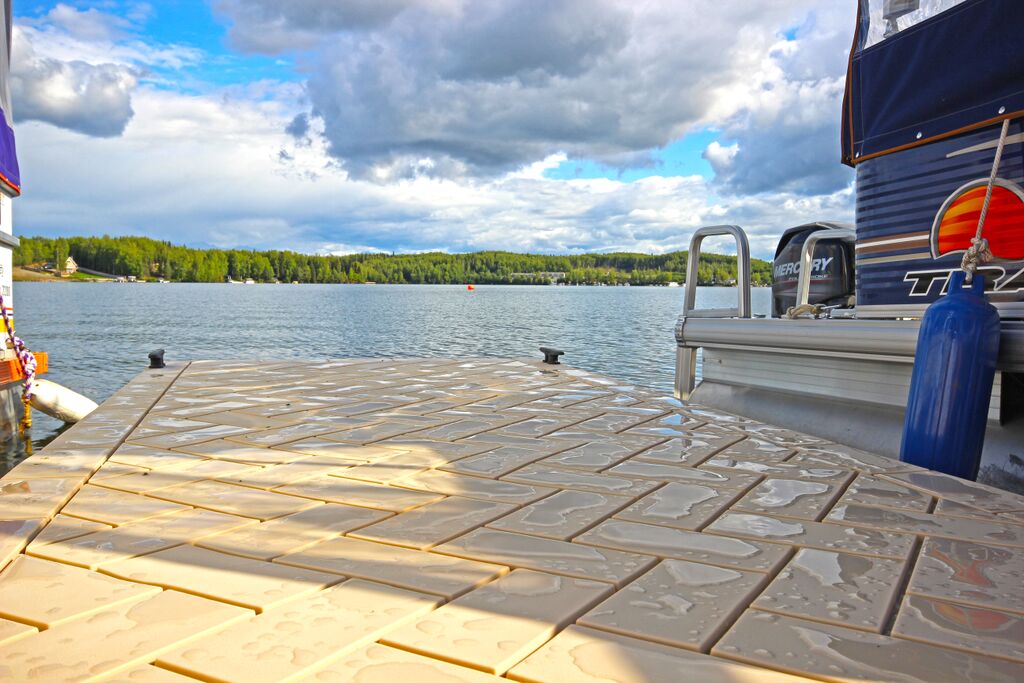How Do Floating Docks Handle Fluctuating Water Levels?
Seasonal weather changes throughout the year can raise or lower water levels, and wind, boat traffic, tides, currents, and other parts of the environment can also have an impact. Floating docks help mitigate the changes caused by natural patterns by keeping the dock surface above the water level at all times. Floating docks use foam or air-filled chambers that make them buoyant enough to float on top of the water rather than break it as it moves. These chambers are usually made out of materials like marine-grade polyethylene or another material that can be layered to remain durable and lightweight. Some floating dock models have hollowed-out chambers underneath to trap air like a suction cup which allows for floating dock stability even when water levels change.
Did you know that floating docks are also better for the water in some ways? They’re connected to the shore but also held in place with anchors rather than piles or legs. This means minimal disruption to the bed below. While this system is also great for shorelines with very sudden and deep drop-offs that legs can’t reach, minimal impact on the bottom is also great for the environmentally conscious boater who wants to keep the water beautiful.
Kyungho Yoon and his team's study, along with Petar Cerovac's insights, shed light on the cutting-edge developments in floating dock technology. Yoon's research into optimizing ballasting plans revolutionizes how floating docks adjust to changes in water levels and loads, making them more efficient for construction and maintenance (Yoon et al., 2020). Cerovac's focus on engineering precision complements this, highlighting the need for meticulous planning in floating dock construction to ensure they stand up to the challenges of fluctuating water environments (Cerovac, 2005). These advancements resonate with what we do at PolyDock. Our floating docks are designed with these innovative ideas in mind, ensuring they're not just durable and reliable but also adaptable to the dynamic nature of waterfronts. It's all about staying afloat and stable, no matter what the water decides to do!
Benefits of a Floating Dock System
All waterfronts can benefit from the installation of a dock. Docks enhance the experience and value of your time on the water, give you easier access to your watercraft and other equipment, and are an ideal place to spend time — whether you’re hosting parties or unplugging for a little while. Floating dock systems are beneficial for and used in all types of water for various applications for these reasons and others. A floating dock system works just as well on private waterfronts as it does in public parks or industry applications. You’ll also get these benefits out of your floating dock system:
- Easy entry and exit, no matter how high or low the water, because your dock and vessel are always level
- Fewer pieces of sensitive hardware and no applications of harmful chemical treatments — cleaning is as easy as waiting for it to rain, or you can use soap, water, or a pressure washer for a thorough, quick clean
- Your electrical systems are safe with a floating dock system, which won’t let them become submerged when the water level rises
- Easy boat lift installation, removal, and layout changes, especially with modular dock systems.
PolyDock Floating Docks for Fluctuating Water
Floating docks are a great way to keep your boat or jet ski safe and accessible, no matter the weather. If you think a floating dock is right for you, PolyDock is a great place to get one. Get in touch with a PolyDock today to get started building your environmentally friendly floating dock system.
Cerovac, P. (2005). ENGINEERING-SURVEY WORK IN THE CONSTRUCTION OF FLOATING DOCKS. Survey Review, 38, 11 - 24. https://www.tandfonline.com/doi/abs/10.1179/sre.2005.38.295.11
Yoon, K., Kim, H., Yeo, S., Hong, Y., Cha, J., & Chung, H. (2020). Ballasting plan optimization for operation of a 2D floating dry dock. Structural Engineering and Mechanics, 74, 521-532.




